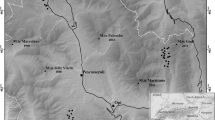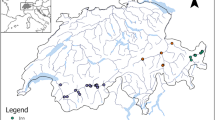Abstract
We asked: (i) Which environmental factors determine the level of α-diversity at several scales and β-diversity in steppic grasslands? (ii) How do the effects of environmental factors on α- and β-diversity vary between the different taxonomic groups (vascular plants, bryophytes, lichens)? We sampled nested-plot series ranging from 0.0001 to 100 m2 and additional 10-m2 plots, covering different vegetation types and management regimes in steppes and semi-natural dry grasslands of Central Podolia (Ukraine). We recorded all terricolous taxa and used topographic, soil, land-use and climatic variables as predictors. Richness-environment relationships at different scales and across taxonomic groups were assessed with multimodel inference. We also fitted power-law species-area relationships, using the exponent (z value) as a measure of β-diversity. In general, the richness values in the study region were intermediate compared to those known from similar grasslands throughout the Palaearctic, but for 1 cm2 we found seven species of vascular plants, a new world record. Heat index was the most important factor for vascular plants and bryophytes (negative relation), while lichen diversity depended mainly on stone and rock cover (positive). The explanatory power of climate-related variables increased with increasing grain size, while anthropogenic burning was the most important factor for richness patterns at the finest grain sizes (positive effect). The z values showed more variation at the finest grain sizes, but no significant differences in their mean between scales. The results highlight the importance of integrating scale into ecological analyses and nature conservation assessments in order to understand and manage biological diversity in steppe ecosystems.



Similar content being viewed by others
References
Alekhin VV (1986) Theoretical problems of the phytocenology and steppe science. Moscow University Publishing House, Moscow
Bartoń K (2015) MuMIn: Multi-Model Inference. R package version 1.14.0. https://r-forge.r-project.org/scm/viewvc.php/*checkout*/www/MuMIn-manual.pdf?revision=347&root=mumin. Accessed 1 Jan 2016
Becker T, Brändel M (2007) Vegetation-environment relationship in a heavy metal-dry grassland complex. Folia Geobot 42:11–28
Bilyk HI (1973a) Basic patterns of distribution of the steppes vegetation of USSR. In: Barbarich AI (ed) Vegetation of the UkrSSR. Steppes, rocky outcrops, sands. Naukova Dumka, Kyiv, pp 14–18
Bilyk HI (1973b) Mesoxerophytic grassland. In: Barbarich AI (ed) Vegetation of the UkrSSR. Steppes, rocky outcrops, sands. Naukova Dumka, Kyiv, pp 33–94
Bilyk HI (1977) Euro-Siberian forest-steppe region. Geobotanical zonation of the USSR. Naukova Dumka, Kyiv, pp 140–195
Bivand R, Piras G (2015) Comparing implementations of estimation methods for spatial econometrics. J Stat Softw 63:1–36
Bohn U, Gollub G, Hettwer C, Neuhäuslová Z, Raus T, Schlüter H, Weber H, Hennekens S (eds) (2004) Map of the natural vegetation of Europe. Scale 1 : 2 500 000. Interactive CD-ROM: explanatory text, legend, maps. Bundesamt für Naturschutz, Bonn
Burkovsky OP, Vasyliuk OV, Yena AV, Kuzemko AA, Movchan YI, Moysienko II, Sirenko IP (2013) Last steppes of Ukraine: to be or not to be. Geoprynt, Kyiv
Burnham KP, Anderson DR (2002) Model selection and multimodel inference: a practical information-theoretic approach, 2nd edn. Springer, New York
Chytrý M, Dražil T, Hájek M, Kalnóková V, Preslerová Z, Šibik J, Ujházy K, Axmanová I, Bernátová D et al (2015) The most species-rich plant communities in the Czech Republic and Slovakia (with new world records). Preslia 87:217–278
Connell JH (1978) Diversity in tropical rain forests and coral reefs. Science 199:1302–1310
Connor EF, McCoy ED (1979) The statistics and biology of the species-area relationship. Am Nat 113:791–833
de Bello F, Lepš J, Sebastià MT (2007) Grazing effects on the species-area relationship: variation along a climatic gradient in NE Spain. J Veg Sci 18:25–34
Dengler J (2005) Zwischen Estland und Portugal: Gemeinsamkeiten und Unterschiede der Phytodiversitätsmuster europäischer Trockenrasen. Tuexenia 25:387–405
Dengler J (2009a) Which function describes the species-area relationship best? a review and empirical evaluation. J Biogeogr 36:728–744
Dengler J (2009b) A flexible multi-scale approach for standardised recording of plant species richness patterns. Ecol Indic 9:1169–1178
Dengler J, Boch S (2008) Sampling-design effects on properties of species-area curves: a case study from Estonian dry grassland communities. Folia Geobot 43:289–304
Dengler J, Becker T, Ruprecht E, Szabó A, Becker U, Beldean M, Bita-Nicolae C, Dolnik C, Goia I, Peyrat J, Sutcliffe LME, Turtureanu PD, Uğurlu E (2012) Festuco-Brometea communities of the Transylvanian Plateau (Romania): a preliminary overview on syntaxonomy, ecology, and biodiversity. Tuexenia 32:319–359
Dengler J, Janišová M, Török P, Wellstein C (2014) Biodiversity of Palaearctic grasslands: a synthesis. Agric Ecosyst Environ 182:1–14
Didukh YP, Shelyag-Sosonko YR (2003) Geobotanic zoning of Ukraine and adjacent areas. Ukr Bot J 60(1):6–17 (in Ukrainian)
Drakare S, Lennon JJ, Hillebrand H (2006) The imprint of the geographical, evolutionary and ecological context on species-area relationships. Ecol Lett 9:215–227
Dupré C, Diekmann M (2001) Differences in species richness and life-history traitsbetween grazed and abandoned grasslands in southern Sweden. Ecography 24:275–286
Ewald J (2003) The calcareous riddle: why are there so many calciphilous species in the Central European flora? Folia Geobot 38:357–366
Giladi I, Ziv Y, May F, Jeltsch F (2011) Scale-dependent determinants of plant species richness in a semi-arid fragmented agro-ecosystem. J Veg Sci 22:983–996
Grime JP (1973) Competitive exclusion in herbaceous vegetation. Nature 242:344–347
Habel JC, Dengler J, Janišová M, Török P, Wellstein C, Wiezik M (2013) European grassland ecosystems: threatened hotspots of biodiversity. Biodivers Conserv 22:2131–2138
Hijmans RJ, Cameron SE, Parra JL, Jones PG, Jarvis A (2005) Very high resolution interpolated climate surfaces for global land areas. Int J Climatol 25:1965–1978
Hopp D, Dengler J (2015) Scale-dependent species diversity in a semi-dry basiphilous grassland (Bromion erecti) of Upper Franconia (Germany). Bull Eurasian Dry Grassl Group 28:10–15
Kleiber C, Zeileis A (2008) Applied econometrics with R. Springer, New York
Korotchenko I, Peregrym M (2012) Ukrainian steppes in the past at present and in the future. In: Werger MJA, van Staalduinen MA (eds) Eurasian steppes. Ecological problems and livelihoods in a changing world. Springer, Dordrecht, pp 173–196
Kuzemko AA, Becker T, Didukh YP, Ardelean IV, Becker U, Beldean M, Dolnik C, Jeschke M, Naqinezhad A, Uğurlu E, Ünal A, Vassilev K, Vorona EI, Yavorska OH, Dengler J (2014) Dry grassland vegetation of Central Podolia (Ukraine): a preliminary overview of its syntaxonomy, ecology and biodiversity. Tuexenia 34:391–430
Liamine N (ed) (2002a) The continental biogeographical region: agriculture, fragmentation and big rivers. Eur Environ Agency. http://www.eea.europa.eu/publications/report_2002_0524_154909/biogeographical-regions-in-europe/continental_biogeografical_region.pdf. Accessed 28 Sept 2015
Liamine N (ed) (2002b) The steppic region: the plains of Europe. Eur Environ Agency. http://www.eea.europa.eu/publications/report_2002_0524_154909/biogeographical-regions-in-europe/continental_biogeografical_region.pdf. Accessed 28 Sept 2015
Lipinsky VM, Diachuk VA, Babichenko VM (eds) (2003) Climate of Ukaine. Vyd-vo Rayevs’kogo, Kyiv (in Ukrainian)
Löbel S, Dengler J, Hobohm C (2006) Species richness of vascular plants, bryophytes and lichens in dry grasslands: the effects of environment, landscape structure and competition. Folia Geobot 41:377–393
Merunková K, Preislerová Z, Chytrý M (2014) Environmental drivers of species composition and richness in dry grasslands of northern and central Bohemia, Czech Republic. Tuexenia 34:447–466
Moysienko II, Zachwatowicz M, Sudnik-Wójcikowska B, Jabłońska E (2014) Kurgans help to protect endangered steppe species in the Pontic grass steppe zone, Ukraine. Wulfenia 21:83–94
Müller J, Klaus VH, Kleinebecker T, Prati D, Hölzel N, Fischer M (2012) Impact of land-use intensity and productivity on bryophyte diversity in agricultural grasslands. PLoS One 7:e51520. doi:10.1371/journal.pone.0051520
Olsson PA, Mårtensson LM, Bruun HH (2009) Acidification of sandy grasslands: consequences for plant diversity. Appl Veg Sci 12:350–361
Palpurina S, Chytrý M, Tzonev R, Danihelka J, Axmanová I, Merunková K, Duchoň M, Karakiev T (2015) Patterns of fines-scale plant species richness in dry grasslands across the eastern Balkan Peninsula. Acta Oecol 63:36–46
Pärtel M (2002) Local plant diversity patterns and evolutionary history at the regional scale. Ecology 83:2361–2366
Pedashenko H, Apostolova I, Boch S, Ganeva A, Janisová M, Sopotlieva D, Todorova S, Ünal A, Vassilev K, Velev N, Dengler J (2013) Dry grasslands of NW Bulgarian mountains: first insights into diversity, ecology and syntaxonomy. Tuexenia 33:309–346
Reed RA, Peet RK, Palmer MW, White PS (1993) Scale dependence of vegetation-environment correlations: a case study of a North Carolina piedmont woodland. J Veg Sci 4:329–340
Roleček J, Čornej II, Tokarjuk AI (2014) Understanding the extreme species richness of semi-dry grasslands in east-central Europe: a comparative approach. Preslia 86:13–34
Schuster B, Diekmann M (2003) Changes in species density along the soil pH gradient: evidence from German plant communities. Folia Geobot 38:367–379
Shmida A, Wilson MV (1985) Biological determinants of species diversity. J Biogeogr 12:1–20
Siefert A, Ravenscroft C, Althoff D, Alvarez-Yépiz JC, Carter BE, Glennon KL, Heberling JM, Jo IS, Pontes A, Sauer A, Willis A, Fridley JD (2012) Scale dependence of vegetation-environment relationships: a meta-analysis of multivariate data. J Veg Sci 23:942–951
Škornik S, Vidrih M, Kaligarič M (2010) The effect of grazing pressure on species richness, composition nd productivity in North Adriatic Karst pastures. Plant Biosyst 144:355–364
Solomakha VA (2008) The syntaxonomy of vegetation of the Ukraine. The third approximation, Phytosociocentre, Kyiv (in Ukrainian)
Tamme R, Hiiesalu I, Laanisto L, Szava-Kovats R, Pärtel M (2010) Environmental heterogeneity, species diversity and co-existence at different spatial scales. J Veg Sci 21:796–801
Turtureanu PD, Palpurina S, Becker T, Dolnik C, Ruprecht E, Sutcliffe LME, Szabó A, Dengler J (2014) Scale- and taxon-dependent biodiversity patterns of dry grassland vegetation in Transylvania. Agric Ecosyst Environ 182:15–24
Vrahnakis MS, Janišová M, Rūsiņa S, Török P, Venn S, Dengler J (2013) The European Dry Grassland Group (EDGG): stewarding Europe’s most diverse habitat type. In: Baumbach H, Pfützenreuter S (eds) Steppenlebensräume Europas: Gefährdung, Erhaltungsmaßnahmen und Schutz. Thüringer Ministerium für Landwirtschaft, Forsten, Umwelt und Naturschutz, Erfurt, pp 417–434
Werger MJA, van Staalduinen MA (eds) (2012) Eurasian steppes. Ecological problems and livelihoods in a changing world. Springer, Dordrecht
Wilson JB, Peet RK, Dengler J, Pärtel M (2012) Plant species richness: the world records. J Veg Sci 23:796–802
Acknowledgments
The study was jointly planned by J.D. (methodology) and A.A.K. (site selection and field work). A.A.K, T.B., Y.P.D., A.N. E.U., K.V. and J.D. were involved in the field sampling, while C.D. and M.J. determined critical cryptogams, and T.P. analysed the soil samples. M.J.S. (multimodel inference) and J.D. (species-area relationships) carried out the statistical analyses. The text was drafted by A.A.K, J.D. and M.J.S. while all authors critically revised it. We thank Ioana Violeta Ardelean, Ute Becker, Monica Beldean, Ina Cultasov, Thomas Haberler, Yulia Kazmirova, Igor Kuzemko, Aslan Ünal, Evgeniy I. Vorona and Olena H. Yavorska for their invaluable help with the field sampling, the Förderkreis für Allgemeine Naturkunde (Biologie) (www.fan-b.de) and the European Dry Grassland Group (EDGG; www.edgg.org) for financial support of the research expedition as well as the International Association for Vegetation Science (IAVS; http://www.iavs.org) and BAYHOST (http://www.uni-regensburg.de/bayhost), which made the three short research stays of the first author in the groups of the last author in Hamburg and Bayreuth possible, during which the analyses were conducted and the paper drafted. Laura Sutcliffe kindly polished our English language usage. Finally, we thank the co-ordinating editor, Péter Török, and two anonymous reviewers for their thoughtful comments, which contributed significantly to the improvement of the manuscript.
Author information
Authors and Affiliations
Corresponding author
Additional information
Communicated by Péter Török.
Electronic supplementary material
Below is the link to the electronic supplementary material.
Rights and permissions
About this article
Cite this article
Kuzemko, A.A., Steinbauer, M.J., Becker, T. et al. Patterns and drivers of phytodiversity in steppe grasslands of Central Podolia (Ukraine). Biodivers Conserv 25, 2233–2250 (2016). https://doi.org/10.1007/s10531-016-1060-7
Received:
Revised:
Accepted:
Published:
Issue Date:
DOI: https://doi.org/10.1007/s10531-016-1060-7




